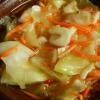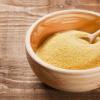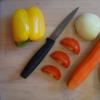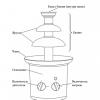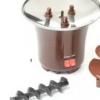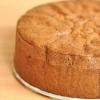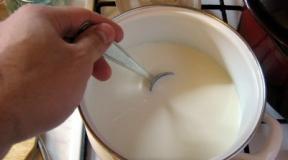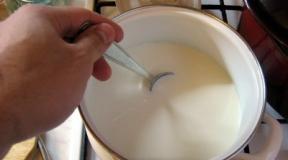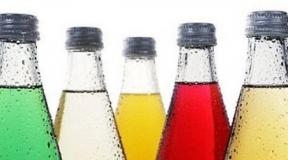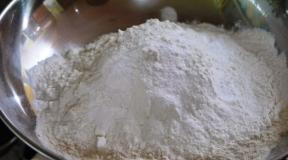Tomato paste GOST 3343 89. Concentrated tomato products
page 1

page 2

page 3

page 4

page 5

page 6

page 7

page 8

page 9

page 10
1.2.5. According to the "Color" indicator, determined by one of the methods according to GOST 8756.8, concentrated tomato products must correspond to the values \u200b\u200bspecified in Table. 2.
|
table 2 |
|||||||||||||||||||||||||||||||||||||||||||||||||||||||||||||||||||||||||||||||||||||||||||||||||||||||||
|
|||||||||||||||||||||||||||||||||||||||||||||||||||||||||||||||||||||||||||||||||||||||||||||||||||||||||
1.2.6. According to physical and chemical indicators, concentrated tomato products must comply with the standards indicated in Table. 3.
1.2.7. Microbiological indicators of concentrated tomato products are established in accordance with the procedure for sanitary and technical control of canned food at manufacturing enterprises, wholesale depots, retail trade and catering establishments, approved by the USSR Ministry of Health.
1.2.8. The mass fraction of heavy metals and arsenic should not exceed the standards approved by the USSR Ministry of Health.
1.3. Package
1.3.1. Concentrated tomato products are packaged:
in metal barrels according to normative and technical documentation, with a capacity of not more than 100 dm 3;
aseptically preserved concentrated tomato products:
in polymer containers of the "bag in a box" type according to the normative and technical documentation, with a capacity of not more than 200 dm3;
1.4. Marking
The details of the quality document are established in accordance with the procedure for sanitary and technical control of canned food at manufacturing enterprises, wholesale depots, retail trade and catering establishments, approved by the USSR Ministry of Health.
2.2. The frequency of checking heavy metals and arsenic in canned food is established in accordance with the procedure approved by the USSR Ministry of Health and the USSR State Agrarian Industry.
3. TEST METHODS
Organoleptic indicators (appearance and texture, color, taste and smell) of concentrated tomato juice are determined after dilution with distilled water in a ratio of 1:5.
GOST 3343-89 S. 6
Determination of the indicator "Color" by one of the methods according to GOST 8756.8 is carried out in case of disagreement in the organoleptic evaluation of the color of concentrated tomato products.
3.2. Foreign impurities are determined visually.
3.3. Determination of heavy metals and arsenic is carried out according to GOST 26927, GOST 26930 - GOST 26935.
3.4. Sampling methods for microbiological analyzes - according to GOST 26668, sample preparation - according to GOST 26669.
3.5. Microbiological analyzes, if necessary, to confirm industrial sterility, are carried out according to GOST 10444.1, GOST 10444.11, GOST 10444.12, GOST 26670, GOST 30425.
3.6. An analysis for spoilage agents is carried out if necessary to confirm microbial spoilage in accordance with GOST 10444.1, GOST 10444.11, GOST 10444.12, GOST 10444.15, GOST 26670, GOST 30425.
3.7. Analysis for pathogenic microorganisms is carried out at the request of the State Sanitary Inspection in the laboratories indicated by them according to GOST 10444.1, GOST 10444.2, GOST 10444.7, GOST 10444.8, GOST 10444.9, GOST 26670.
3.8. Determination of mold content according to Howard - according to GOST 10444.14.
4. TRANSPORT AND STORAGE
4.1. Transportation and storage - in accordance with GOST 13799.
Salted tomato paste in barrels is stored at a relative humidity of no more than 80%.
Tomato paste in a container made of polymeric materials is stored at a temperature of 0 to 8 °C.
It is allowed to store tomato paste in tank containers at a temperature not lower than minus 10 °C.
4.2. Shelf life of concentrated tomato products from the date of production:
in glass jars - 3 years;
in metal cans, barrels, bag-in-box plastic containers, tank containers - 1 year;
in aluminum tubes - 6 months;
in containers made of polymeric materials - 10 days.
APPENDIX 1 Reference
Name of product
91 6211 5010 91 6211 5030 91 6212 3010 91 6212 3030 91 6212 3050 91 6212 3070
91 6212 5070 91 6212 5090 91 6212 5110 91 6212 5120
Concentrated tomato juice with a mass fraction of solids 40%>, premium
Concentrated tomato juice with a mass fraction of solids 40%>, first grade
Concentrated tomato juice with salt and spices, first grade Tomato paste with a solids content of 25%, unsalted, extra
Tomato paste with a mass fraction of solids 30%, unsalted, extra
Tomato paste with a mass fraction of solids 35%, unsalted, extra
Tomato paste with a mass fraction of solids 40%, unsalted, extra
Tomato paste with a mass fraction of solids 25%, unsalted, premium
Tomato paste with a mass fraction of solids 30%, unsalted, premium
Tomato paste with a mass fraction of solids 35%, unsalted, premium
Tomato paste with a mass fraction of solids 40%, unsalted, premium
Tomato paste with a mass fraction of solids 25%, unsalted, first grade
Tomato paste with a mass fraction of solids 30%, unsalted, first grade
Tomato paste with a mass fraction of solids 35%, unsalted, first grade
Tomato paste with a mass fraction of solids 40%, unsalted, first grade
Tomato paste with a mass fraction of solids 27%, salted, first grade
Tomato paste with a mass fraction of solids 32%, salted, first grade
Tomato paste with a mass fraction of solids 37%, salted, first grade
Tomato puree with a mass fraction of solids 12%, unsalted, higher
Tomato puree with a mass fraction of solids 15%, unsalted, premium
Tomato puree with a mass fraction of solids 20%, unsalted, premium
Tomato puree with a mass fraction of solids 12%, unsalted, first grade
Tomato puree with a mass fraction of solids 15%, unsalted, first grade
Tomato puree with a mass fraction of solids 20%, unsalted, first grade
APPENDIX 2 Reference
NUTRITIONAL AND ENERGY VALUE OF 100 g CONCENTRATED TOMATO PRODUCTS
|
Name |
Carbohydrates, g |
Vitamins, mg |
Energy |
|||
|
product |
P-carotene |
value, kcal |
||||
|
Tomato puree, %: | ||||||
|
Tomato paste, %: | ||||||
INTERSTATE STANDARD
TOMATO CONCENTRATED PRODUCTS
GENERAL SPECIFICATIONS
Official edition
Standartinform
UDC 664.841:635.64:006.354
INTERSTATE
Group H53
STANDARD
TOMATO CONCENTRATED PRODUCTS General specifications
Concentrated tomato foods. 3343-89
General specifications
MKS 67.080.20 OKP 91 6211; 91 6212
Date of introduction 01.01.91
This standard applies to concentrated tomato products obtained from fresh tomatoes or tomato mass, with or without the addition of salt and spice extracts, and establishes requirements for products manufactured for the needs of the national economy and export.
1. TECHNICAL REQUIREMENTS
1.1. Concentrated tomato products must be manufactured in accordance with the requirements of this standard according to the technological instructions and recipes in compliance with the sanitary rules approved in the prescribed manner.
1.2. Characteristics
1.2.1. Concentrated tomato products are produced in the following types:
tomato puree;
tomato paste;
1.2.2. Depending on the quality indicators, concentrated tomato products are divided into varieties:
tomato puree, concentrated tomato juice - the highest and first;
tomato paste - extra, supreme and first.
Salted tomato paste and concentrated tomato juice with salt and spices are produced only of the first grade.
The names of concentrated tomato products and OKP codes are listed in Appendix 1.
1.2.3. For the manufacture of concentrated tomato products, the following raw materials and materials are used:
fresh tomatoes;
tomato mass (pulp)* *;
edible salt;
С0 2 - extracts of spices;
essential oils.
Raw materials and materials must comply with the requirements of regulatory and technical documentation.
Tomatoes are not allowed for processing, in which the residual amount of pesticides exceeds the maximum allowable levels, and the nitrate content is the norm approved by the USSR Ministry of Health.
It is not allowed to add artificial colors and synthetic flavors to concentrated tomato products.
1.2.4. According to organoleptic indicators, concentrated tomato products must meet the requirements specified in Table. one.
* Used in the production of only tomato puree and tomato paste.
Official publication Reprint prohibited
© Standards Publishing House, 1990 © Standartinform, 2008
|
Variety characteristics | |||||
|
Name | |||||
|
indicator |
tomato paste |
Concentrated tomato juice |
Tomato puree and tomato paste |
Concentrated tomato juice |
|
|
Appearance and con |
Homogeneous end |
Homogeneous end |
homogenous homo |
Homogeneous end |
homogenous homo |
|
sistentia |
adjusted mass ma |
trimmed mass from |
weighted gene mass |
trimmed mass from |
weighted gene mass |
|
chewy texture, |
semi-liquid to smear |
shenny fine-grinding |
semi-liquid to smear |
shenny fine-grinding |
|
|
no dark inclusions |
thick consistency (in |
particles |
thick consistency (in |
particles |
|
|
skin remnants, |
mass |
fruit pulp, without |
mass |
fruit pulp, without |
|
|
miang and other rough cha |
howling fraction of soluble |
dark inclusions, os |
howling fraction of soluble |
dark inclusions. Before |
|
|
fruit needles |
cpx substances), free of dark inclusions, residues of seed skins and other coarse fruit particles |
skins, seeds and other coarse fruit particles |
solids), without dark inclusions, coarse fruit particles. Single inclusions of seeds and skin particles are allowed |
single particles of crushed seeds and skins are released |
|
|
Red, orange |
Red, orange |
Red various |
Red, orange |
Red various |
|
|
red or crimson |
red or crimson |
shades, typical |
red or crimson |
shades, typical |
|
|
red, bright |
red, uniform |
for juice from mature volume |
red, uniform |
for juice from mature volume |
|
|
feminine, uniform throughout the mass |
throughout the mass |
tov, pronounced |
throughout the mass. A brownish or brownish tint is allowed. For salted tomato paste, red or dark red with a yellowish tinge | ||
|
Taste and smell |
Peculiar to concentrated tomato |
peculiar to juice |
Peculiar con |
peculiar to juice |
|
|
mass, without bitterness, burning and other extraneous taste and smell |
from ripe tomatoes that have undergone heat treatment, without bitterness, burnt and other foreign taste and smell |
centered tomato mass, without bitterness, scorching and other extraneous taste and smell. Salty flavor for tomato paste with added salt |
from ripe tomatoes that have undergone heat treatment, less pronounced, with or without the aroma of spices, without bitterness, scorching and other extraneous taste and smell. Slightly salted taste for concentrated tomato juice with added salt |
||
1.2.5. According to the "Color" indicator, determined by one of the methods according to GOST 8756.8, concentrated tomato products must correspond to the values \u200b\u200bspecified in Table. 2.
table 2
|
The value of the color index of concentrated tomato products, not more than | ||||||
|
Name products |
Top grade |
First grade |
||||
|
According to the iodine scale, mg / cm 3 |
on the iodine scale, mg / cm 3 |
according to the device Tomacolor, cases. uel. scales |
According to the iodine scale, mg / cm 3 |
according to the device Tomacolor, cases. uel. scales |
||
|
Tomato puree with a mass fraction of soluble solids,%: | ||||||
|
Tomato paste with a mass fraction of soluble solids,%: | ||||||
|
Salted tomato paste with a mass fraction of soluble solids,%: | ||||||
|
Concentrated tomato juice | ||||||
|
Concentrated tomato juice with salt and spices | ||||||
1.2.6. According to physical and chemical indicators, concentrated tomato products must comply with the standards indicated in Table. 3.
1.2.7. Microbiological indicators of concentrated tomato products are established in accordance with the procedure for sanitary and technical control of canned food at manufacturing enterprises, wholesale depots, retail trade and catering establishments, approved by the USSR Ministry of Health.
1.2.8. The mass fraction of heavy metals and arsenic should not exceed the standards approved by the USSR Ministry of Health.
1.3. Package
1.3.1. Concentrated tomato products are packaged:
in glass jars according to GOST 5717.2 with a capacity of not more than 1 dm 3, concentrated tomato juice not more than 0.65 dm 3, corked with varnished metal lids;
in metal lacquered jars according to GOST 5981 with a capacity of not more than 1 dm 3, concentrated tomato juice not more than 0.65 dm 3;
in aluminum tubes according to normative and technical documentation with a capacity of not more than 0.2 dm 3;
tomato paste with a mass fraction of soluble solids of at least 30% - in containers made of polystyrene and other thermoplastic polymeric materials according to normative and technical documentation with a capacity of not more than 0.25 dm3, permitted by the USSR Ministry of Health for contact with food products.

Note. The mass fraction of sugars is determined in salted tomato paste for export.
GOST 3343-S9 С.
It is allowed to seal containers made of polymeric materials with snap-on lids made of the same material.
At the request of the consumer, concentrated tomato products are packaged in glass jars with a capacity of 2 and 3 dm 3 and varnished metal jars with a capacity of 3 to 10 dm 3 .
The inner surface of metal cans and lids must have a two-layer coating that ensures the safety of products during the shelf life.
Concentrated tomato products, except for concentrated tomato juice, intended for industrial processing, are packaged:
in glass jars with a capacity of up to 10 dm 3;
salted tomato paste:
in wooden barrels in accordance with GOST 8777, with a capacity of not more than 100 dm 3, with polyethylene bags - liners in accordance with GOST 19360;
in metal barrels according to normative and technical documentation, with a capacity of not more than 100 dm 3;
aseptically preserved concentrated tomato products:
in polymer containers of the "bag in a box" type according to the normative and technical documentation, with a capacity of not more than 200 dm3;
in tank containers according to GOST 26380 or other similar tank containers.
Metal drums and tank containers must be made of non-corrosive metal or other materials with protective coatings approved by the public health authorities.
1.3.2. Packaging - according to GOST 13799.
1.4. Marking
1.4.1. Marking - in accordance with GOST 13799. For concentrated tomato juice, the degree of dilution must be indicated on the label.
1.4.2. Marking of canned food for export should be done by lithography on the label or directly on the can, lid or tube and contain:
name of canned food;
net weight in grams;
name of the manufacturer;
date of manufacture;
the name of the foreign economic organization and the inscription "Made in ... (name of the manufacturing country)" .
1.4.3. Information on the nutritional and energy value of concentrated tomato products is given in Appendix 2.
1.5. Requirements for the quality of concentrated tomato products for export, packaging and labeling must comply with the requirements of the agreement (contract) of the supplier with a foreign economic organization or a foreign buyer.
2. ACCEPTANCE
2.1. Acceptance rules - according to GOST 26313.
The details of the quality document are established in accordance with the procedure for sanitary and technical control of canned food at manufacturing enterprises, wholesale depots, retail trade and catering establishments, approved by the USSR Ministry of Health.
2.2. The frequency of checking heavy metals and arsenic in canned food is established in accordance with the procedure approved by the USSR Ministry of Health and the USSR State Agrarian Industry.
3. TEST METHODS
3.1. Sampling - according to GOST 26313, sample preparation - according to GOST 26671, GOST 26929, test methods - according to GOST 8756.1, GOST 8756.8, GOST 8756.13, GOST 8756.18, GOST 25555.0, GOST 25555.3, section. 4, GOST 26186, GOST 26323, sec. 2.
Organoleptic indicators (appearance and texture, color, taste and smell) of concentrated tomato juice are determined after dilution with distilled water in a ratio of 1:5.
Determination of the indicator "Color" by one of the methods according to GOST 8756.8 is carried out in case of disagreement in the organoleptic evaluation of the color of concentrated tomato products.
3.2. Foreign impurities are determined visually.
3.3. The determination of heavy metals and arsenic is carried out according to GOST 26927, GOST 26930 - GOST 26935.
3.4. Sampling methods for microbiological analyzes - according to GOST 26668, sample preparation - according to GOST 26669.
3.5. Microbiological analyzes, if it is necessary to confirm industrial sterility, are carried out according to GOST 10444.1, GOST 10444.11, GOST 10444.12, GOST 26670, GOST 30425.
3.6. An analysis for spoilage pathogens is carried out if it is necessary to confirm microbial spoilage in accordance with GOST 10444.1, GOST 10444.11, GOST 10444.12, GOST 10444.15, GOST 26670, GOST 30425.
3.7. Analysis for pathogenic microorganisms is carried out at the request of the State Sanitary Inspection in the laboratories indicated by them according to GOST 10444.1, GOST 10444.2, GOST 10444.7, GOST 10444.8, GOST 10444.9, GOST 26670.
3.8. Determination of mold content according to Howard - according to GOST 10444.14.
4. TRANSPORT AND STORAGE
4.1. Transportation and storage - according to GOST 13799.
Salted tomato paste in barrels is stored at a relative humidity of no more than 80%.
Tomato paste in a container made of polymeric materials is stored at a temperature of 0 to 8 °C.
It is allowed to store tomato paste in tank containers at a temperature not lower than minus 10 °C.
4.2. Shelf life of concentrated tomato products from the date of production:
in glass jars - 3 years;
in metal cans, barrels, bag-in-box plastic containers, tank containers - 1 year;
in aluminum tubes - 6 months;
in containers made of polymeric materials - 10 days.
APPENDIX 1 Reference
OKP CODES
Name of product
Concentrated tomato juice with a mass fraction of solids 40%>, premium
Concentrated tomato juice with a mass fraction of solids 40%>, first grade
Concentrated tomato juice with salt and spices, first grade Tomato paste with a solids content of 25%, unsalted, extra
Tomato paste with a mass fraction of solids 30%, unsalted, extra
Tomato paste with a mass fraction of solids 35%, unsalted, extra
Tomato paste with a mass fraction of solids 40%, unsalted, extra
Tomato paste with a mass fraction of solids 25%, unsalted, premium
Tomato paste with a mass fraction of solids 30%, unsalted, premium
Tomato paste with a mass fraction of solids 35%, unsalted, premium
Tomato paste with a mass fraction of solids 40%, unsalted, premium
Tomato paste with a mass fraction of solids 25%, unsalted, first grade
Tomato paste with a mass fraction of solids 30%, unsalted, first grade
Tomato paste with a mass fraction of solids 35%, unsalted, first grade
Tomato paste with a mass fraction of solids 40%, unsalted, first grade
Tomato paste with a mass fraction of solids 27%, salted, first grade
Tomato paste with a mass fraction of solids 32%, salted, first grade
Tomato paste with a mass fraction of solids 37%, salted, first grade
Tomato puree with a mass fraction of solids 12%, unsalted, higher
Tomato puree with a mass fraction of solids 15%, unsalted, premium
Tomato puree with a mass fraction of solids 20%, unsalted, premium
Tomato puree with a mass fraction of solids 12%, unsalted, first grade
Tomato puree with a mass fraction of solids 15%, unsalted, first grade
Tomato puree with a mass fraction of solids 20%, unsalted, first grade
91 6211 5010 91 6211 5030 91 6212 3010 91 6212 3030 91 6212 3050 91 6212 3070
91 6212 5070 91 6212 5090 91 6212 5110 91 6212 5120
APPENDIX 2 Reference
NUTRITIONAL AND ENERGY VALUE OF 100 g CONCENTRATED TOMATO PRODUCTS
|
Name |
Carbohydrates, g |
Vitamins, mg |
Energy |
|||
|
product |
P-carotene |
value, kcal |
||||
|
Tomato puree,%>: | ||||||
|
Tomato paste,%>: | ||||||
|
Salted tomato paste, %: | ||||||
|
Concentrated | ||||||
|
fresh tomato juice | ||||||
INFORMATION DATA
1. DEVELOPED AND INTRODUCED by the State Agro-Industrial Committee of the USSR DEVELOPERS
B. I. Lerner; S. N. Galkina, Ph.D. tech. sciences; M. D. Babenko; D. I. Babina; L. A. Kondratskaya;
S. Yu. Gelfand, Ph.D. tech. sciences; S. K. Tamkovich; A. E. Melnik; M. Ya. Mozul; E. M. Ryba-lova
2. APPROVED AND INTRODUCED BY Decree of the USSR State Committee for Standards No. 2869 dated September 25, 1989
3. INSTEAD OF GOST 3343-71, GOST 10.8-69, OST 18-72-72, TU 10-03-545-87
4. REFERENCE REGULATIONS AND TECHNICAL DOCUMENTS
|
Item number |
Item number |
||
|
GOST 5717.2-2003 |
GOST 19360-74 | ||
|
GOST 5981-88 |
GOST 25555.0-82 | ||
|
GOST 8756.1-79 |
GOST 25555.3-82 | ||
|
GOST 8756.8-85 |
GOST 26186-84 | ||
|
GOST 8756.13-87 |
GOST 26313-84 | ||
|
GOST 8756.18-70 |
GOST 26323-84 | ||
|
GOST 8777-80 |
GOST 26380-84 | ||
|
GOST 10444.1-84 |
GOST 26668-85 | ||
|
GOST 10444.2-94 |
GOST 26669-85 | ||
|
GOST 10444.7-86 |
GOST 26670-91 | ||
|
GOST 10444.8-88 |
GOST 26671-85 | ||
|
GOST 10444.9-88 |
GOST 26927-86 | ||
|
GOST 10444.11-89 |
GOST 26929-94 | ||
|
GOST 10444.12-88 |
GOST 26930-86- | ||
|
GOST 10444.14-91 |
GOST 26935-86 | ||
|
GOST 10444.15-94 GOST 13799-81 |
1.3.2, 1.4.1, 4.1 |
GOST 30425-97 |
5. The limitation of the validity period was removed according to the protocol No. 5-94 of the Interstate Council for Standardization, Metrology and Certification (IUS 11-12-94)
6. REPUBLICATION. November 2007
1.2.7. Microbiological indicators of concentrated tomato products are established in accordance with the procedure for sanitary and technical control of canned food at manufacturing enterprises, wholesale depots, retail trade and catering establishments, approved by the USSR Ministry of Health.
1.2.8. The mass fraction of heavy metals and arsenic should not exceed the standards approved by the USSR Ministry of Health.
1.3. Package
1.3.1. Concentrated tomato products are packaged:
- in glass jars according to GOST 5717.2 with a capacity of not more than 1 dm 3, concentrated tomato juice not more than 0.65 dm 3, corked with varnished metal lids;
- in metal lacquered jars according to GOST 5981 with a capacity of not more than 1 dm 3, concentrated tomato juice not more than 0.65 dm 3;
- in aluminum tubes according to normative and technical documentation with a capacity of not more than 0.2 dm 3;
- tomato paste with a mass fraction of soluble solids of at least 30% - in containers made of polystyrene and other thermoplastic polymeric materials according to normative and technical documentation with a capacity of not more than 0.25 dm3, permitted by the USSR Ministry of Health for contact with food products.
It is allowed to seal containers made of polymeric materials with snap-on lids made of the same material.
At the request of the consumer, concentrated tomato products are packaged in glass jars with a capacity of 2 and 3 dm 3 and varnished metal jars with a capacity of 3 to 10 dm 3 .
The inner surface of metal cans and lids must have a two-layer coating that ensures the safety of products during the shelf life.
Concentrated tomato products, except for concentrated tomato juice, intended for industrial processing, are packaged:
- in glass jars with a capacity of up to 10dm 3;
salted tomato paste:
- in wooden barrels in accordance with GOST 8777, with a capacity of not more than 100 dm 3, with polyethylene bags liners - in accordance with GOST 19360;
- in metal barrels according to normative and technical documentation, with a capacity of not more than 100 dm 3;
aseptically preserved concentrated tomato products:
- in polymer containers of the "bag in a box" type according to the normative and technical documentation, with a capacity of not more than 200 dm3;
- in tank containers according to GOST 26380 or other similar tank containers.
Metal drums and tank containers must be made of non-corrosive metal or other materials with protective coatings approved by the public health authorities.
1.3.2. Packing - according to GOST 13799.
1.4. Marking
1.4.1. Marking - according to GOST 13799. For concentrated tomato juice, the degree of dilution must be indicated on the label.
1.4.2. Marking of canned food for export should be done by lithography on the label or directly on the can, lid or tube and contain:
- name of canned food;
- net weight in grams;
- name of the manufacturer;
- date of manufacture;
- the name of the foreign economic organization and the inscription "Made in ... (name of the country of manufacture)".
1.4.3. Information about the nutritional and energy value of concentrated tomato products is listed in Appendix 2.
1.5. Requirements for the quality of concentrated tomato products for export, packaging and labeling must comply with the requirements of the agreement (contract) of the supplier with a foreign economic organization or a foreign buyer.
2. ACCEPTANCE
2.1. Acceptance rules - according to GOST 26313.
The details of the quality document are established in accordance with the procedure for sanitary and technical control of canned food at manufacturing enterprises, wholesale depots, retail trade and catering establishments, approved by the USSR Ministry of Health.
2.2. The frequency of checking heavy metals and arsenic in canned food is established in accordance with the procedure approved by the USSR Ministry of Health and the USSR State Agrarian Industry.
3. TEST METHODS
3.1. Sampling - according to GOST 26313, sample preparation - according to GOST 26671, GOST 26929, test methods - according to GOST 8756.1, GOST 8756.8, GOST 8756.13, GOST 8756.18, GOST 255555.0, GOST 255555.3, sec. 4, GOST 26186, GOST 26323, section 2.
Organoleptic indicators (appearance and consistency, color, taste and smell) of concentrated tomato juice are determined after dilution with distilled water in accordance with 1:5.
Determination of the indicator "Color" by one of the methods of GOST 8756.8 is carried out in case of disagreement in the organoleptic evaluation of the color of concentrated tomato products.
3.2. Foreign impurities are determined visually.
3.3. The determination of heavy metals and arsenic is carried out according to GOST 26927, GOST 26930 - GOST 26935.
3.4. Sampling methods for microbiological analyzes - according to GOST 26668, sample preparation - according to GOST 26669.
3.5. Microbiological analyzes, if it is necessary to confirm industrial sterility, are carried out according to GOST 10444.1, GOST 10444.11, GOST 10444.12, GOST 26670, GOST 30425.
3.6. An analysis for spoilage pathogens is carried out if it is necessary to confirm microbial spoilage according to GOST 10444.1, GOST 10444.11, GOST 10444.12, GOST 10444.15, GOST 26670, GOST 30425.
3.7. Analysis for pathogenic microorganisms is carried out according to the requirements of the State Sanitary Inspection in the laboratories indicated by them according to GOST 10444.1, GOST 10444.2, GOST 10444.7, GOST 10444.8, GOST 10444.9, GOST 26670.
3.8. Determination of mold content according to Howard - according to GOST 10444.14.
4. TRANSPORT AND STORAGE
4.1. Transportation and storage - according to GOST 13799.
Salted tomato paste in barrels is stored at a relative humidity of no more than 80%.
Tomato paste in containers made of polymeric materials is stored at a temperature of 0 to 8°C.
It is allowed to store tomato paste in tank containers at a temperature not lower than minus 10°C.
4.2. Shelf life of concentrated tomato products from the date of production:
- in glass jars - 3 years;
- in metal cans, barrels, bag-in-box plastic containers, tank containers - 1 year;
- in aluminum tubes - 6 months;
- in a container made of polymeric materials - 10 days.
GOST 3343-2017
INTERSTATE STANDARD
TOMATO CONCENTRATED PRODUCTS
General specifications
Concentrated tomato products. General specifications
MKS 67.080.20
Introduction date 2019-01-01
Foreword
Foreword
The goals, basic principles and basic procedure for carrying out work on interstate standardization are established in GOST 1.0-2015 "Interstate standardization system. Basic provisions" and GOST 1.2-2015 "Interstate standardization system. Interstate standards, rules and recommendations for interstate standardization. Rules for the development, adoption, updating and cancellation "
Information about the standard
1 DEVELOPED by the Federal State Budgetary Scientific Institution "All-Russian Research Institute of Canning Technology" (FGBNU "VNIITEK")
2INTRODUCED by the Federal Agency for Technical Regulation and Metrology
3 ADOPTED by the Interstate Council for Standardization, Metrology and Certification (Minutes of November 30, 2017 N 52-2017)
4 By order of the Federal Agency for Technical Regulation and Metrology dated December 12, 2017 N 1919-st, the interstate standard GOST 3343-2017 was put into effect as the national standard of the Russian Federation from January 1, 2019.
5INTRODUCED FOR THE FIRST TIME
Information about changes to this standard is published in the annual information index "National Standards", and text changes and amendments - in the monthly information index "National Standards". In case of revision (replacement) or cancellation of this standard, the corresponding notice will be published in the monthly information index "National Standards". The relevant information, notice and texts are also placed in the public information system - on the official website of the Federal Agency for Technical Regulation and Metrology on the Internet (www.gost. ru)
1 area of use
This standard applies to concentrated tomato products obtained from fresh tomatoes, or semi-finished tomato products (crushed tomatoes), or aseptically preserved concentrated tomato products (hereinafter referred to as concentrated tomato products).
2 Normative references
This standard uses normative references to the following interstate standards:
GOST8.579-2002 State system for ensuring the uniformity of measurements. Requirements for the quantity of packaged goods in packages of any kind during their production, packaging, sale and import
GOST ISO750-2013 Fruit and vegetable processing products. Determination of titratable acidity
GOST ISO762-2013 Fruit and vegetable processing products. Determination of the content of mineral impurities
GOST ISO2173-2013 Processed fruits and vegetables. Refractometric method for the determination of soluble solids
GOST 5717.1-2014 Glass containers for preserving food products. General specifications
GOST5717.2-2003 Glass jars for canned food. Main parameters and dimensions
GOST 5981-2011 Metal cans and lids for them for canned food. Specifications
GOST6709-72 Distilled water. Specifications
GOST ISO7218-2015 Microbiology of food and animal feed. General requirements and recommendations for microbiological studies
GOST8756.1-79 Canned food products. Methods for determining organoleptic indicators, net weight or volume and mass fraction of constituents
GOST 8756.18-70 Canned food products. Method for determining the appearance, tightness of containers and the state of the inner surface of metal containers
GOST 10444.1-84 Canned food. Preparation of solutions of reagents, dyes, indicators and nutrient media used in microbiological analysis
GOST EN12014-2-2014 Food products. Determination of nitrate and (or) nitrite. Part 2. Determination of nitrate in vegetables and products of their processing by high performance liquid chromatography and ion chromatography
GOST 13799-2016 Processed products of fruits, vegetables and mushrooms. Packaging, labeling, transportation and storage
GOST EN14083-2013 Food products. Determination of trace elements. Determination of lead, cadmium, chromium and molybdenum using atomic absorption spectrometry with atomization in a graphite furnace with preliminary mineralization of the sample at elevated pressure
GOST14192-96 Cargo marking
GOST ISO17240-2017 Fruit and vegetable processing products. Determination of tin content by flame atomic absorption spectrometry
GOST 25749-2005 Metal screw caps. General specifications
GOST 26186-84 Processed products of fruits and vegetables, canned meat and meat and vegetables. Methods for the determination of chlorides
GOST 26313-2014 Fruit and vegetable processing products. Acceptance rules and sampling methods
GOST 26323-2014 Fruit and vegetable processing products. Methods for determining the content of impurities of plant origin
GOST 26380-84 Specialized group containers. Types, basic parameters and dimensions
GOST 26669-85 Food and flavor products. Sample preparation for microbiological analysis
GOST 26671-2014 Processed products of fruits and vegetables, canned meat and meat and vegetables. Sample preparation for laboratory analysis
GOST 26927-86 Food raw materials and products. Methods for the determination of mercury
GOST 26929-94 Food raw materials and products. Sample preparation. Mineralization to determine the content of toxic elements
GOST 26930-86 Food raw materials and products. Arsenic determination method
GOST 26932-86 Food raw materials and products. Methods for the determination of lead
GOST 26933-86 Food raw materials and products. Methods for determining cadmium
GOST 28038-2013 Fruit and vegetable processing products. Method for determination of mycotoxin patulin
GOST 28322-2014 Processed products of fruits, vegetables and mushrooms. Terms and definitions
GOST 29270-95 Processed fruits and vegetables. Methods for determining nitrates
GOST 30178-96 Food raw materials and products. Atomic absorption method for the determination of toxic elements
GOST 30349-96 Fruits, vegetables and products of their processing. Methods for determination of residual amounts of organochlorine pesticides
GOST 30425-97 Canned food. Method for determining industrial sterility
GOST 30538-97 Food products. Method for determining toxic elements by atomic emission method
GOST 30669-2000 Processed fruits and vegetables. Gas chromatographic method for determining the content of benzoic acid
GOST 30670-2000 Processed fruits and vegetables. Gas chromatographic method for determining the content of sorbic acid
GOST 30710-2001 Fruits, vegetables and products of their processing. Methods for determination of residual amounts of organophosphorus pesticides
GOST 31628-2012 Food products and food raw materials. Stripping voltammetric method for determining the mass concentration of arsenic
GOST 31671-2012 (EN 13805:2002) Food products. Definition of trace elements. Sample preparation by mineralization under elevated pressure
GOST 31707-2012 (EN 14627:2005) Food products. Definition of trace elements. Determination of total arsenic and selenium by atomic absorption spectrometry with generation of hydrides with preliminary mineralization of the sample under pressure
GOST 31904-2012 Food products. Sampling methods for microbiological testing
GOST 33303-2015 Food products. Sampling methods for the determination of mycotoxins
GOST 33332-2015 Fruit and vegetable processing products. Determination of the mass fraction of sorbic and benzoic acids by high performance liquid chromatography
GOST 33406-2015 Alcoholic, non-alcoholic and juice products, flavor additives. Determination of the content of synthetic dyes by high performance liquid chromatography
GOST 33437-2015 Juice products. Determination of chlorides by potentiometric titration
GOST 33457-2015 Fruit and vegetable processing products. Method for the qualitative determination of synthetic dyes using ion-pair extraction
GOST 33479-2015 Fruit and vegetable processing products. Determination of color by colorimetric method
GOST 33824-2016 Food products and food raw materials. Stripping voltammetric method for determining the content of toxic elements (cadmium, lead, copper and zinc)
GOST 33977-2016 Fruit and vegetable processing products. Methods for determining total solids
Note - When using this standard, it is advisable to check the validity of reference standards in the public information system - on the official website of the Federal Agency for Technical Regulation and Metrology on the Internet or according to the annual information index "National Standards", which was published as of January 1 of the current year, and by the release of the monthly information index for the current year. If the reference standard is replaced (modified), then when using this standard, you should be guided by the replacing (modified) standard. If the referenced standard is canceled without replacement, the provision in which the reference to it is given applies to the extent not affecting that reference.
3Terms and definitions
This standard uses the terms according to GOST 28322, as well as the following terms with their respective definitions:
3.1 "Hot Break": The process of making tomato paste, in which the crushed tomato mass is heated before rubbing at a temperature of 85 to 100 ° C.
3.2 "Cold Break": The process of making tomato paste, in which the crushed tomato mass is heated before rubbing at a temperature of 55 to 84 ° C.
4Classification
4.1 Concentrated tomato products are manufactured in the following types:
Tomato puree;
tomato paste;
Tomato juice.
4.2 Depending on the quality indicators, concentrated tomato products are produced in the "Extra" category (from fresh raw materials) or without a category designation.
4.3 Depending on the viscosity of the final product, tomato paste is prepared from fresh tomatoes using the following technologies: "Hot Break" and "ColdBreak".



